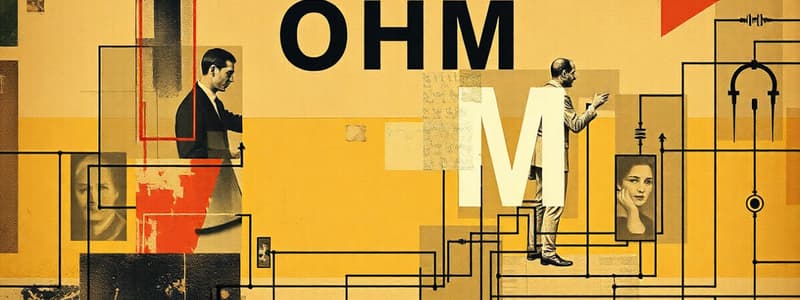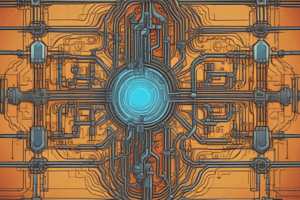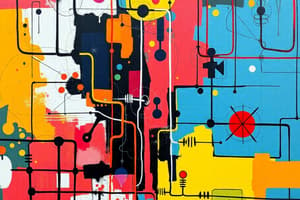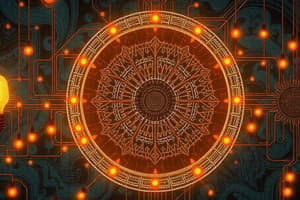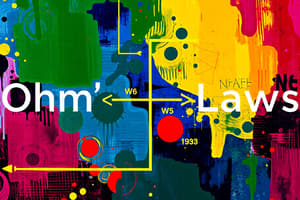Podcast
Questions and Answers
Which component primarily opposes the flow of electric current?
Which component primarily opposes the flow of electric current?
- Diode
- Resistor (correct)
- Inductor
- Capacitor
What is the primary function of a diode in a circuit?
What is the primary function of a diode in a circuit?
- Allow current to flow in one direction only (correct)
- Store energy in an electric field
- Provide a low-resistance path
- Oppose current flow
Which law states that the total current entering a junction equals the total current leaving it?
Which law states that the total current entering a junction equals the total current leaving it?
- Kirchhoff's Voltage Law
- Ohm's Law
- Ampere's Law
- Kirchhoff's Current Law (correct)
For a circuit with a 12V battery and a resistor of 4Ω, what is the current flowing through the circuit?
For a circuit with a 12V battery and a resistor of 4Ω, what is the current flowing through the circuit?
In a parallel circuit, what remains constant across all components?
In a parallel circuit, what remains constant across all components?
How is electrical energy typically measured?
How is electrical energy typically measured?
What is the formula for calculating electrical power when voltage and current are known?
What is the formula for calculating electrical power when voltage and current are known?
What does grounding in electrical systems aim to prevent?
What does grounding in electrical systems aim to prevent?
Flashcards
What is current?
What is current?
The flow of electric charge, measured in amperes (A). Its direction is conventionally the flow of positive charge.
What is voltage?
What is voltage?
Electric potential difference, the driving force for current, measured in volts (V).
What is resistance?
What is resistance?
Opposition to current flow, measured in ohms (Ω).
What is power?
What is power?
Signup and view all the flashcards
Describe Ohm's Law.
Describe Ohm's Law.
Signup and view all the flashcards
What is a series circuit?
What is a series circuit?
Signup and view all the flashcards
What is a parallel circuit?
What is a parallel circuit?
Signup and view all the flashcards
What is a resistor?
What is a resistor?
Signup and view all the flashcards
Study Notes
Basic Electrical Concepts
- Current (I): The flow of electric charge. Measured in amperes (A). Direction is conventionally the flow of positive charge.
- Voltage (V): Electric potential difference, driving force for current. Measured in volts (V).
- Resistance (R): Opposition to current flow. Measured in ohms (Ω).
- Power (P): Rate at which electrical energy is used or supplied. Measured in watts (W).
- Ohm's Law: States the relationship between voltage, current, and resistance: V = IR. This fundamental law is crucial for understanding circuit behavior.
- Series Circuits: Components are connected end-to-end. Current is the same through each component. Total resistance adds up.
- Parallel Circuits: Components are connected across the same voltage points. Voltage is the same across each component. Reciprocal of total resistance is the sum of reciprocals of individual resistances.
- Kirchhoff's Laws: Provide methods for analyzing complex circuits.
- Kirchhoff's Current Law: The total current entering a junction equals the total current leaving the junction.
- Kirchhoff's Voltage Law: The sum of voltage drops around any closed loop in a circuit equals zero.
Types of Current
- Direct Current (DC): Current flows in one direction.
- Alternating Current (AC): Current periodically reverses direction.
Circuit Components
- Resistor: A device that opposes current flow.
- Capacitor: Stores energy in an electric field.
- Inductor: Stores energy in a magnetic field.
- Diode: Allows current to flow in one direction, blocking it in the opposite direction.
Power and Energy
- Electrical Power: The rate at which electrical energy is converted into other forms of energy, like heat or motion, in a circuit. Determined either by voltage and current (P = IV) or voltage and resistance (P = V²/R) or current and resistance (P = I²R).
- Electrical Energy: The capacity to do work. Over time, total energy used/supplied is the integral of power. Measured in joules (J) over time.
Safety Considerations
- Grounding: Providing a low-resistance path for current to flow to the earth, preventing dangerous voltage buildup.
- Electrical Shock: A potentially hazardous encounter with electricity, ranging from mild tingling to fatal cardiac arrest. Understanding current paths and magnitudes is crucial for risk mitigation.
- Overcurrent Protection: Devices like fuses or circuit breakers interrupt circuit current to prevent damage from overloads or short circuits.
Studying That Suits You
Use AI to generate personalized quizzes and flashcards to suit your learning preferences.
